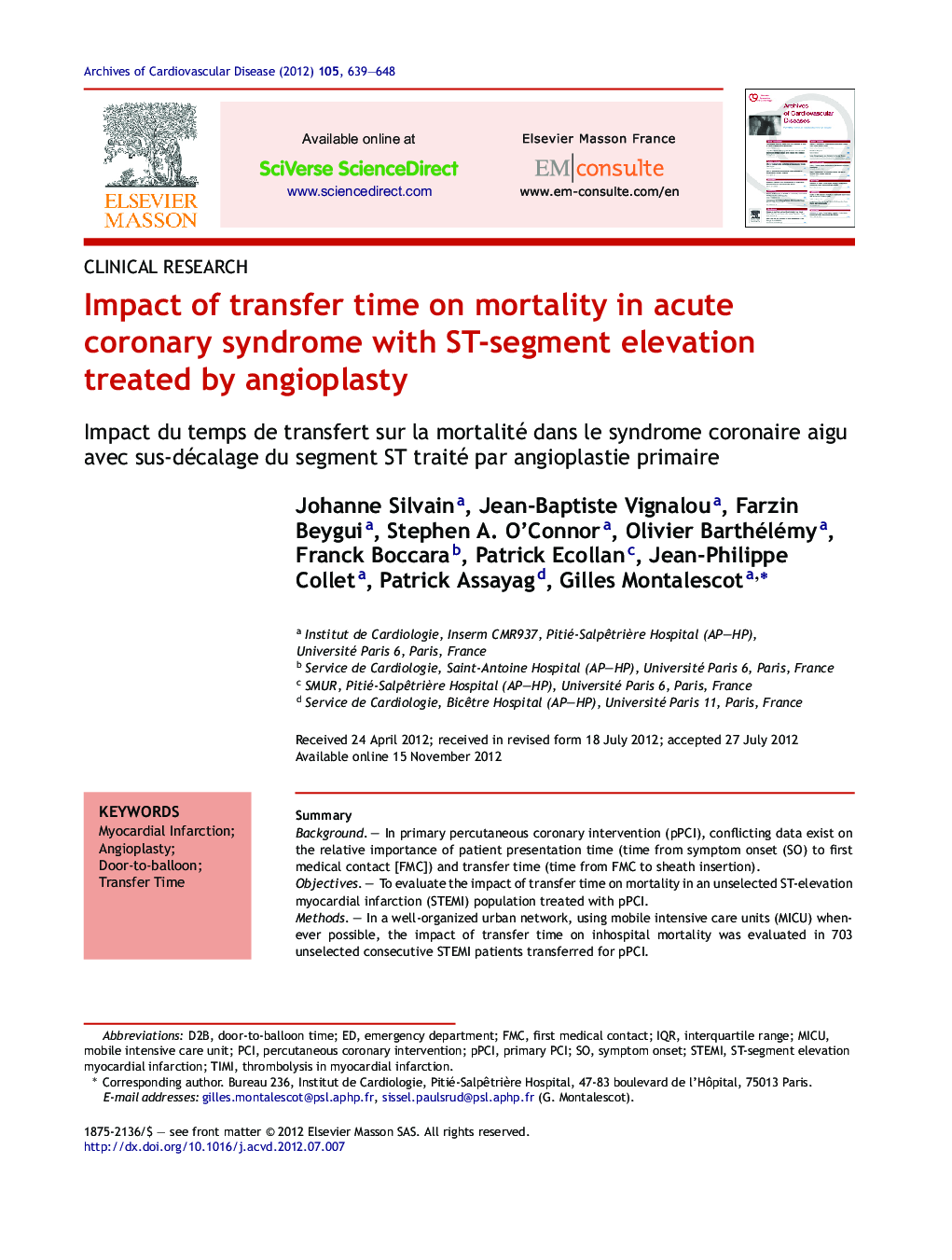| کد مقاله | کد نشریه | سال انتشار | مقاله انگلیسی | نسخه تمام متن |
|---|---|---|---|---|
| 2889446 | 1574369 | 2012 | 10 صفحه PDF | دانلود رایگان |

SummaryBackgroundIn primary percutaneous coronary intervention (pPCI), conflicting data exist on the relative importance of patient presentation time (time from symptom onset (SO) to first medical contact [FMC]) and transfer time (time from FMC to sheath insertion).ObjectivesTo evaluate the impact of transfer time on mortality in an unselected ST-elevation myocardial infarction (STEMI) population treated with pPCI.MethodsIn a well-organized urban network, using mobile intensive care units (MICU) whenever possible, the impact of transfer time on inhospital mortality was evaluated in 703 unselected consecutive STEMI patients transferred for pPCI.ResultsOur STEMI population included patients with cardiogenic shock (5.3%) and out-of-hospital cardiac arrest (3.7%). Longer transfer times were found to be associated with a stepwise increase in mortality ranging from 2.99% in the first quartile (Q1) up to 8.65% in the fourth quartile (Q4) (P = 0.005). This result was noted in patients presenting early (≤ 2 h of SO, 0.96% for Q1 vs. 9.8% for Q4, P = 0.006) but not in late presenters (> 2 h of SO, 7.00% for Q1 vs. 7.8% for Q4, P = 0.85). After adjustment for confounding variables such as the severity of patients, the relationship between mortality and transfer time was no longer apparent.ConclusionsIn a well-organized urban network dedicated to pPCI, including unselected STEMI patients, transfer time does not appear to be a major contributor to mortality. The relationship of transfer time to mortality seems to be dependent on presentation time and patients’ clinical severity.
RésuméContexteIl existe peu de données sur l’importance pronostique relative du délai de présentation du patient (début des symptômes [DS] – premier contact médical) et du temps de transfert (premier contact médical-insertion du désilet) dans le SCA ST+ traité par angioplastie primaire (AP).ObjectifÉvaluer l’impact indépendant du temps de transfert sur la mortalité intrahospitalière dans le SCA ST+ traité par AP.Matériel et méthodesDans un réseau urbain organisé utilisant le SAMU, l’impact du temps de transfert sur la mortalité intrahospitalière a été évalué chez 703 patients SCA ST+ non sélectionnés transférés pour AP.RésultatsLa population de l’étude comprenait des chocs cardiogéniques (5,3 %) et des arrêts cardiaques extrahospitaliers (3,7 %). L’allongement du temps de transfert était associé à une augmentation progressive de la mortalité (2,99 % pour le premier quartile [Q1] jusqu’à 8,65 % pour le quatrième quartile [Q4]; p = 0,005). Cette relation était encore plus marquée chez les patients se présentant précocement (≤ 2 h du DS, 0,96 % pour Q1 vs 9,8 % pour Q4; p = 0,006), mais non significative pour les patients se présentant tardivement (> 2 h du DS, 7,00 % pour Q1 vs 7,8 % pour Q4; p = 0,85). En analyse multivariée, le temps de transfert n’était plus associé à la mortalité.ConclusionDans un réseau urbain organisé dédié à l’AP, le temps de transfert ne semble pas être un déterminant majeur de la mortalité. La relation entre le temps de transfert et la mortalité précoce apparaît fortement dépendante du délai de présentation et de la sévérité clinique.
Journal: Archives of Cardiovascular Diseases - Volume 105, Issue 12, December 2012, Pages 639–648